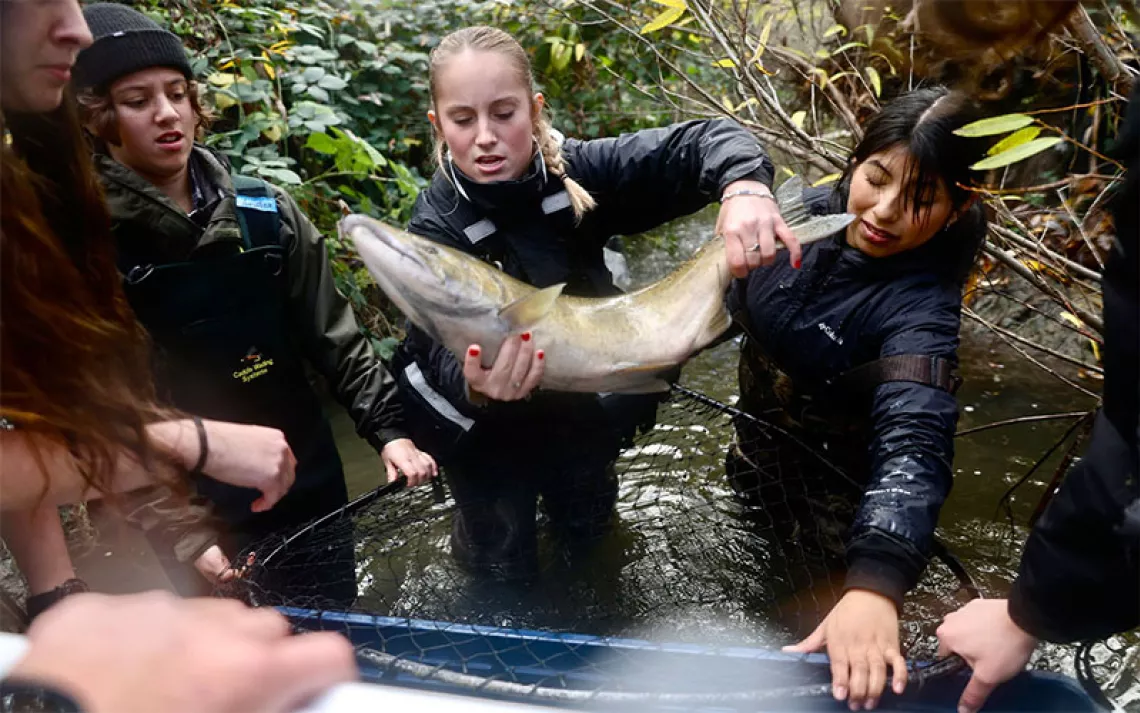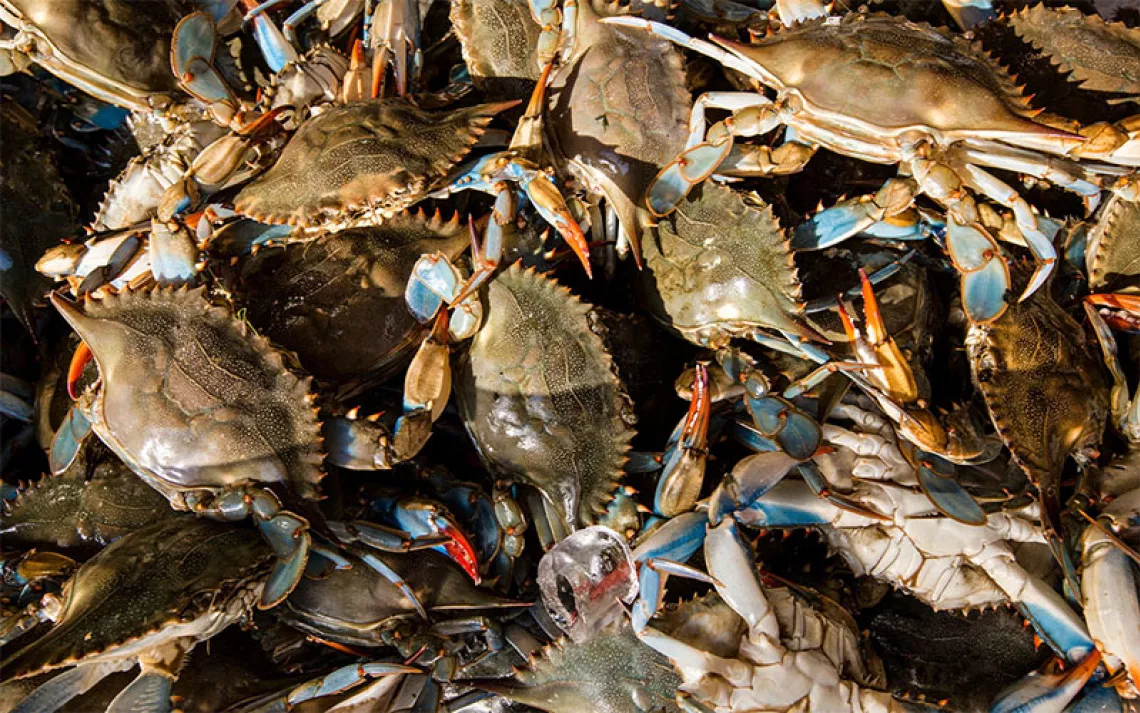The Promise and the Challenge of “Restorative Aquaculture”
Shellfish and seagrass farming can help restore coastal ecosystems, provided farmers are willing to work with nature

A basket of oysters is hoisted from Long Island Sound for Copps Island Oysters off Norwalk, Connecticut. | Photo by AP Photo/Mark Lennihan
The stories of the shrinking Amazon are hard to miss—and hard to stomach. To make room for cattle ranches, impoverished farmers set fires and cut old-growth trees, some of which are over 1,000 years old.
Only a short distance east, another ancient forest is suffering, but the culprit is a different kind of livestock: shrimp. Like the Amazon, mangrove swamps are some of the richest ecosystems on the planet, teeming with tropical fish and birds like the roseate spoonbill. Shrimp ponds load up coastal waters with shrimp waste, which drifts and smothers nearby mangroves.
Aquaculture is one of the world’s fastest-growing food industries, spurred on in many cases by government funding and often at the expense of the environment as coastlines are cleared away to make room for fish, seaweed, and shellfish farms.
But some see an opportunity for compromise and even collaboration between ocean farmers and nature, especially in places that aren’t as pristine as the Amazon. Shellfish and seaweed are valuable crops, but they’re also important species that have gone missing in ecosystems around the world. A broad coalition of politicians, scientists, farmers, and green organizations are touting “restorative aquaculture” as a way to use the growing demand for seafood to bring back lost coastal habitats and wildlife.
“It's going to continue to grow. . . . So how can we direct that growth to be as sustainable as possible?” says Robert Jones, global lead for aquaculture for the Nature Conservancy. In partnership with marine science researchers, the organization has been investigating aquaculture’s potential to restore ecosystems. Along with members from the World Bank, University of New England, World Wildlife Fund, and the Food and Agriculture Organization of the United Nations, among others, they plan to release a paper outlining the core tenets of “restorative aquaculture” later this year.
Amid a worldwide push for more seafood, restorative aquaculture may represent a way to provide food and create jobs while building back oyster reefs and other habitats that have been lost over centuries. But even shellfish and seaweed farming come with environmental costs, and some are skeptical that the industry can expand while leaving room for nature.
Shellfish and seaweed farming are on the rise, but natural habitats built on shellfish and seaweed are shrinking. Researchers and conservationists saw an opportunity. “We started looking at commercial aquaculture from this restoration perspective: Can it help us accelerate or achieve some of the same goals we’ve had for years but do so at much less cost?” says Jones. The idea is catching on. The Ocean-Based Climate Solutions Act introduced earlier this year directs the government to establish a program to “address opportunities, challenges, and innovation in restorative ocean aquaculture.” Among the top places researchers say could benefit from restorative aquaculture: the East Coast of the United States.
Oysters used to grow like weeds in the Chesapeake Bay, but European settlers picked them by the million, and centuries of disease and encroaching waterside industry reduced them to less than 1 percent of their former numbers. “There's just no way to look at it other than gross mismanagement,” says Jackie Shannon, Virginia oyster restoration manager at the Chesapeake Bay Foundation, which is working to restore lost oyster beds. The organization uses old shells donated by restaurants to catch oyster larvae as they float by, giving them a place to settle and grow.
Bringing wild oysters back has been a boon for the bay. Oysters build their own habitat, growing one on top of another and giving shape to an otherwise formless mudflat. This means more surface area for algae and other microscopic species to grow, for grazers like crabs and starfish to roam and hide, and for top predators like striped bass to hunt for prey. The number of fish, crabs, and other creatures on restored oyster beds was much higher than in areas without oysters when scientists surveyed the bay in 2006.
But restoration is expensive—as much as $25,000 per acre for a reef roughly half a foot high, according to Shannon. It’s unclear whether oyster farms provide all the same benefits as wild oysters, but there’s evidence that farms can give more than they take. For example, oyster and clam crops can provide habitat—and a bite to eat—until they’re harvested after about two years. Farmed mussels and seaweed grow on ropes hanging from rafts or longlines, which make the farm more three-dimensional—more space for life to grow. Oyster farms remove about the same level of nitrogen pollution—which washes down from farms upstream—as wild oysters. A recent literature review sponsored by the Nature Conservancy showed that shellfish and seaweed farms can in some cases boost the number and types of animals in the water, compared with unfarmed areas nearby.
The results represent what might be possible with restorative aquaculture, but they vary by farm. “Our study shows that there are generally positive benefits . . . but it's not a universal fact that aquaculture provides habitat or diversity,” says Seth Theuerkauf, a marine biologist who worked on the review for the Nature Conservancy. An ideal farm might grow a native species in an area where kelp forests or mussel beds had been removed. It might use suspended equipment like oyster rack-and-bags, and it wouldn’t harvest or clean too often or all at once. Even better would be a farm that grew seaweed and shellfish together, according to Theuerkauf’s coauthor Heidi Alleway at the University of Adelaide.
These nuances may be lost in the fray as nations around the world push to expand seafood farming. In sheer tonnage of fish, seaweed, crustaceans, and mollusks, aquaculture has grown by more than 300 percent in the past two decades. Fish farming has many of the same problems as shrimp farming, and under pressure from the industry, it’s been gaining traction in the United States, sparking fears from environmentalists and fishermen alike. Even for lower-impact industries like shellfish and seaweed farming, some say we should proceed with caution. If aquaculture can benefit the ecosystem in principle, it may not always work out that way in practice.
Some shellfish farmers use nets to keep hungry animals at bay, and these are often left behind in the water along with plastics, PVC piping, and other gear. Whales and sea turtles have become tangled in mussel longlines. At harvest time, clam and oyster farmers dredge, rake, and blast the sea bottom with hydraulic jets. When farmers import shellfish, they can unwittingly spread parasites and diseases, like oyster herpes. Until 2002, shellfish growers in Washington State used pesticides to get rid of burrowing shrimp, which stir up the seafloor and cause oysters to sink in the mud. The chemical, carbaryl, was banned, but growers continue to use an herbicide to kill Japanese eelgrass, which is considered a weed. These chemicals are not permitted in other states.
Opening up the sea to farming comes with a lot of risk. “The harmful things we’ve done on land that we're now trying to fix—we're now starting to do in the ocean,” says Jennifer Jacquet, an economist at New York University’s Department of Environmental Studies. While bivalve farming could have environmental benefits in some places “if done correctly,” Jacquet says that’s a big “if.” “We don’t have a good history of that.” In the United States, at least, oysters are a luxury item—restaurant food. Given a choice, food-rich nations may be better off transitioning to a plant-based diet than trusting the industry to make restoration a priority.
It’s important to keep a distinction between restoring ecosystems for nature and using them for aquaculture, says Jacquet. “‘Restorative’ to me means rewilding, remaking what was there before humans, and I don’t think that’s a giant seaweed farm.” Even the animals themselves can be different. Most oysters farmed in the US are sterile—artificially endowed with an extra chromosome—which also makes them plump and easier to market. Mussels, oysters, and clams spawn by spraying sperm and eggs into the water, so farms could potentially contribute baby shellfish to suffering wild populations, but it might make their product less valuable.
Restorative aquaculture requires compromise. “If it’s done in a way where the goal is to maximize the product that is salable, I don’t think [aquaculture] is going to be a good tool” for restoration, says Amy van Saun, a senior attorney at the Center for Food Safety. She says environmental concerns need to be kept front and center. Enforceable regulations and a certification program, like the one used for organic farmers, would be a good start.
An area managed strictly for nature might have more environmental benefits, but restorative aquaculture is an attempt to address the challenges of restoration and hunger at the same time, says Robert Jones. He says that restorative aquaculture isn’t intended to replace traditional restoration, and Jones agrees that caution is warranted. The Nature Conservancy plans to put restorative aquaculture into practice in places like Belize, where seaweed might serve as habitat for lobsters and fish.
In many ways, ocean farmers already have practice working alongside wild nature. “Eider ducks are our biggest nemesis in the animal world,” says Mason Silkes, owner of Salt Water Farms, a mussel and oyster farm in North Kingstown, Rhode Island. The ducks gorge themselves on his crop, diving six feet beneath the water to pluck mussels from the longlines—an undersea buffet that stretches for hundreds of feet. They can eat their way through a farm in a few weeks, says Silkes, and farmers haven’t figured out a good way to keep them out. Other mussel bandits include loons and carnivorous starfish.
The fates of farmed and wild shellfish are bound up together with the health of the oceans. Droughts and heat waves this summer that killed more than a billion sea creatures in the Pacific Northwest also devastated shellfish farms. Coastlines need to be protected from the climate crisis, and restoring ecosystems benefits shellfish farmers and wild shellfish alike.
Whether growing mussels for food or nature, shellfish lovers have much in common, says Chris Moore, a senior scientist at the Chesapeake Bay Foundation. From his office window on the Chesapeake Bay, he can see the Army Corps of Engineers doing oyster restoration work alongside farmers growing shellfish for food.
“Everyone’s trying to get to the same endpoint,” he says. “We all want to see more oysters.”
 The Magazine of The Sierra Club
The Magazine of The Sierra Club



